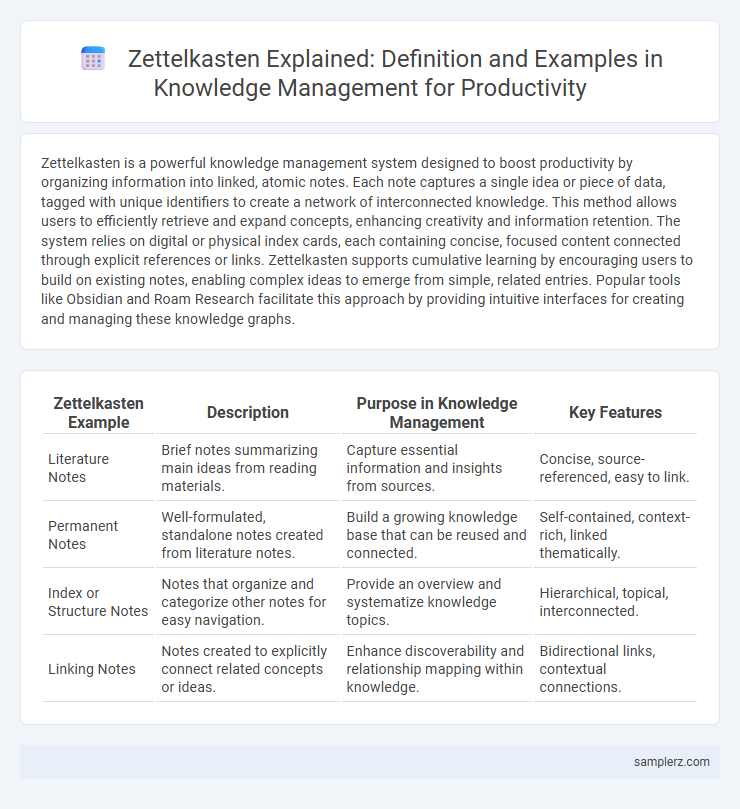Zettelkasten is a powerful knowledge management system designed to boost productivity by organizing information into linked, atomic notes. Each note captures a single idea or piece of data, tagged with unique identifiers to create a network of interconnected knowledge. This method allows users to efficiently retrieve and expand concepts, enhancing creativity and information retention. The system relies on digital or physical index cards, each containing concise, focused content connected through explicit references or links. Zettelkasten supports cumulative learning by encouraging users to build on existing notes, enabling complex ideas to emerge from simple, related entries. Popular tools like Obsidian and Roam Research facilitate this approach by providing intuitive interfaces for creating and managing these knowledge graphs.
Table of Comparison
| Zettelkasten Example | Description | Purpose in Knowledge Management | Key Features |
|---|---|---|---|
| Literature Notes | Brief notes summarizing main ideas from reading materials. | Capture essential information and insights from sources. | Concise, source-referenced, easy to link. |
| Permanent Notes | Well-formulated, standalone notes created from literature notes. | Build a growing knowledge base that can be reused and connected. | Self-contained, context-rich, linked thematically. |
| Index or Structure Notes | Notes that organize and categorize other notes for easy navigation. | Provide an overview and systematize knowledge topics. | Hierarchical, topical, interconnected. |
| Linking Notes | Notes created to explicitly connect related concepts or ideas. | Enhance discoverability and relationship mapping within knowledge. | Bidirectional links, contextual connections. |
Introduction to Zettelkasten in Knowledge Management
Zettelkasten is a powerful method for knowledge management that uses individual, linked index cards to store and organize information. Each card represents a single idea or piece of data, allowing users to create a dynamic network of interrelated concepts that enhances recall and creativity. This system supports efficient knowledge processing by promoting connections between notes, facilitating deeper understanding and streamlined retrieval of information.
How Zettelkasten Enhances Productivity
Zettelkasten enhances productivity by creating a dynamic system for knowledge management that enables quick retrieval and easy connection of ideas. Its structure allows users to break down complex information into atomic notes, fostering deeper understanding and efficient content creation. By linking notes contextually, Zettelkasten reduces cognitive load and accelerates problem-solving processes.
Key Components of a Zettelkasten System
A Zettelkasten system's key components include atomic notes, unique identifiers, and a robust linking structure that enables seamless navigation and idea association. Each atomic note captures a single concept or piece of information, fostering clarity and precise retrieval. The interlinked notes create a dynamic knowledge network, enhancing productivity by facilitating creative thinking and efficient knowledge synthesis.
Step-by-Step Process for Creating Zettelkasten Notes
Begin by capturing fleeting notes on ideas or information quickly using simple phrases or keywords. Transform these into permanent notes by rewriting content in your own words and linking them contextually within your Zettelkasten, ensuring each note addresses a single concept. Organize notes using unique IDs and hierarchical tags to facilitate easy retrieval and establish connections, enhancing long-term knowledge synthesis and creative thinking.
Real-World Examples of Zettelkasten Implementation
Real-world examples of Zettelkasten implementation include researchers like Niklas Luhmann, who used the system to produce over 70 books and hundreds of articles by interlinking notes for deep knowledge synthesis. Modern professionals utilize digital Zettelkasten tools such as Obsidian and Roam Research to manage complex information workflows and enhance creativity. Companies implement Zettelkasten-based knowledge management for efficient project documentation and collaborative innovation, improving productivity across teams.
Integrating Zettelkasten with Digital Tools
Integrating Zettelkasten with digital tools enhances knowledge management by enabling seamless linking and retrieval of notes through software such as Obsidian, Roam Research, and Notion. These platforms support bidirectional linking, tags, and rich metadata, facilitating deeper connections between ideas and accelerating research workflows. Utilizing cloud synchronization and powerful search functions further optimizes accessibility and organization within complex knowledge networks.
Zettelkasten for Project and Task Management
Zettelkasten enhances project and task management by organizing discrete notes linked through unique identifiers, enabling seamless retrieval and connection of related information. This method supports efficient tracking of task dependencies, project milestones, and resource allocation by integrating atomic notes that can be dynamically recombined. Utilizing Zettelkasten in project workflows improves clarity, reduces cognitive overload, and fosters a systemic approach to managing complex tasks and deadlines.
Overcoming Common Challenges in Zettelkasten Workflow
Zettelkasten workflow challenges often include information overload, inconsistent note linking, and difficulty in retrieving related ideas. Implementing standardized tagging systems and regular review sessions enhances note organization and cross-linking efficiency. Utilizing digital tools with customizable filters and search functions overcomes retrieval barriers and maintains a seamless productivity flow.
Measuring Productivity Gains with Zettelkasten
Using the Zettelkasten method in knowledge management can significantly enhance productivity by creating a dense network of interconnected ideas, which accelerates information retrieval and creative synthesis. Studies show that users of Zettelkasten report up to a 30% increase in task completion speed due to reduced time spent searching for information. Measuring productivity gains involves tracking time saved in note retrieval and the quality of output generated through improved knowledge integration.
Tips for Sustaining a Productive Zettelkasten Practice
Consistently tagging and linking notes within a Zettelkasten system enhances retrieval speed and idea synthesis, fueling continuous knowledge growth. Allocating dedicated daily time blocks to review and refine notes prevents backlog accumulation and maintains an organized knowledge network. Employing concise, atomic notes paired with clear, descriptive titles boosts comprehension and facilitates seamless integration into broader research projects.

example of Zettelkasten in knowledge management Infographic
 samplerz.com
samplerz.com